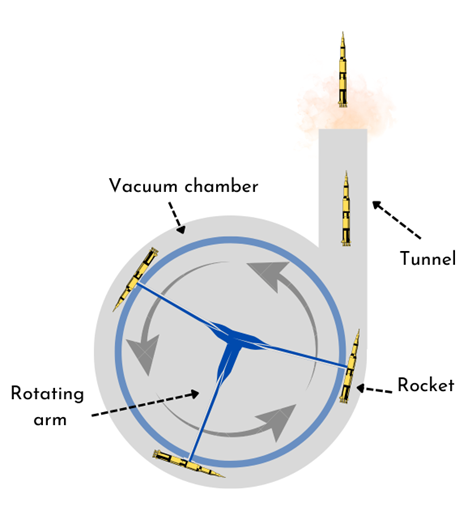Space technology company SpinLaunch has developed a new revolutionary method to launch rockets into space.

Image Credit: Alexyz3d/Shutterstock.com
Based in California, SpinLaunch’s unique rocket launching innovation is being supported by NASA to enter the third phase of R & D. Contrary to traditional rocket launching methods that use fuel-based propulsion, SpinLaunch uses an electrical slingshot to catapult a spacecraft into orbit.
The technology developed by SpinLaunch is based on an orbital accelerator model. A functioning, completed system can lower the cost and time to send payloads into space. With scientific and commercial space exploration expanding rapidly, SpinLaunch’s alternative slinging mechanism broadens the overall access to space as well.
Traditional rocket launching methods can cost up to $100,000 per pound to shuttle a payload into orbit. The emergence of reusable space shuttles, like the ones introduced by SpaceX, has reduced the cost to $2000 per pound. The majority of the costs incurred by these methods rise from the amount of fuel used. Electrically powered, slingshot-type reusable technology can lower the costs even further.
Alternative Rocket Launching Methods
Alternative rocket launching methods have been tried in the past. An example is the High-Frequency Active Auroral Research Program (HAARP) commissioned about 50 years ago. HAARP used a very powerful gun to shoot rockets into the upper atmosphere. The objective of the HAARP project was to analyze the ionosphere. The ionosphere is the portion of the atmosphere that stretches from about 53 to 370 miles above the surface of the earth. Technological limitations available at the time prevented successfully launching rockets into space with this method.
The SpinLaunch Orbital Accelerator
The method devised by SpinLaunch is schematically shown in figure 1. The payload, for example, satellites or spacecraft, are loaded into a rocket. The rocket itself is positioned inside an orbital accelerator lining the inside circumference of the circular vacuum centrifuge.

Figure 1: Schematic illustration of the SpinLaunch orbital accelerator.
The centrifuge, which is vacuum-sealed, is designed to spin the rocket attached to a rotating arm. The roof of the chamber is welded in steel while the walls are made of a thin, strong metal. This ensures that the launch facility can withstand the many forces created within the chamber.
Over several revolutions, the rocket can build up to speeds reaching multiple times the speed of sound. Once adequate launch speed is reached, the rocket is released through a hypersonic header. A tunnel constructed tangentially along the orbital accelerator is positioned at the optimal launch angle to sling the rocket into orbit.
The exit of the launch tunnel through which the rocket is launched is covered by a brittle material. The material is strong enough to resist the vacuum but can also be easily breached by the rocket when it flies out.
The orbital accelerator uses kinetic energy to build up to launch speed.
Multiple electric motors are used to power and spin the rotating arm which is made of a high tensile strength composite.
Traditional rocket launching methods rely on fuel to thrust the rocket perpendicularly from the earth’s surface. Additional fuel on the rocket is burned as the rocket journeys into orbit. The SpinLaunch mechanism reserves more space for payload as less space is needed for fuel.
The launch vehicle is released back to earth after reaching space. Similar to SpaceX, the SpinLaunch vehicle is returned to earth for reuse on future launches.
Timeline
Initial, proof of concept tests of SpinLaunch were carried out in 2017. The diameter of the large vacuum chamber was 12 meters in length. The second phase of development saw the design enlarged to test suborbital flight tests. The vacuum centrifuge chamber was scaled to 33 meters in diameter and suborbital tests were completed in 2021. With NASA’s green light, the next phase of SpinLaunch’s efforts will enlarge the vacuum chamber diameter to 100 meters. The first flight tests are expected to commence by 2025. If successful, commercial payload transport can be launched using the orbital accelerator within this decade.
An Inside Look: SpinLaunch Flight Test #7
Video Credit: SpinLaunch/Youtube.com
Challenges and Outlook
Major challenges encountered by the SpinLaunch mechanism are in scaling the facility for orbital flights. Complications arise in managing the large stress effects on the payload during high-speed rotations. This is due to thousands of g-forces and very high temperatures generated while the centrifuge spins.
Advances in carbon fibers offer lightweight materials that can withstand high-pressure environments. SpinLaunch has adapted such materials in building the orbital accelerator.
To achieve the high speeds required for launch, the vacuum chamber must be maintained at very low pressures. This is another barrier that SpinLaunch will have to overcome when scaling the size of the orbital accelerator. Powerful enough vacuum pumps have to be employed to maintain uniform pressure throughout the chamber. Aerothermal heat produced during the operation of the launch has to be managed carefully.
While several challenges persist, SpinLaunch has embarked on a revolutionary space launching technology. An orbital accelerator-based launch mechanism stands to expedite the future space industry with consistent transport for commercial and scientific use.
References and Further Reading
Coldewey, D. (April 06, 2022). SpinLaunch scores NASA test mission to demonstrate its unique launch method | Techcrunch. https://techcrunch.com/2022/04/06/spinlaunch-scores-nasa-test-mission-to-demonstrate-its-unique-launch-method/
Goodyer, J. (April 20, 2022). NASA to test giant slingshot designed to fling satellites into orbit | Sciencefocus. https://www.sciencefocus.com/news/nasa-to-test-giant-slingshot-designed-to-fling-satellites-into-orbit/
Wall, M. (April 20, 2022). Watch SpinLaunch sling a payload high into the sky in epic test flight video | Space.com. https://www.space.com/spinlaunch-test-flight-video
Disclaimer: The views expressed here are those of the author expressed in their private capacity and do not necessarily represent the views of AZoM.com Limited T/A AZoNetwork the owner and operator of this website. This disclaimer forms part of the Terms and conditions of use of this website.